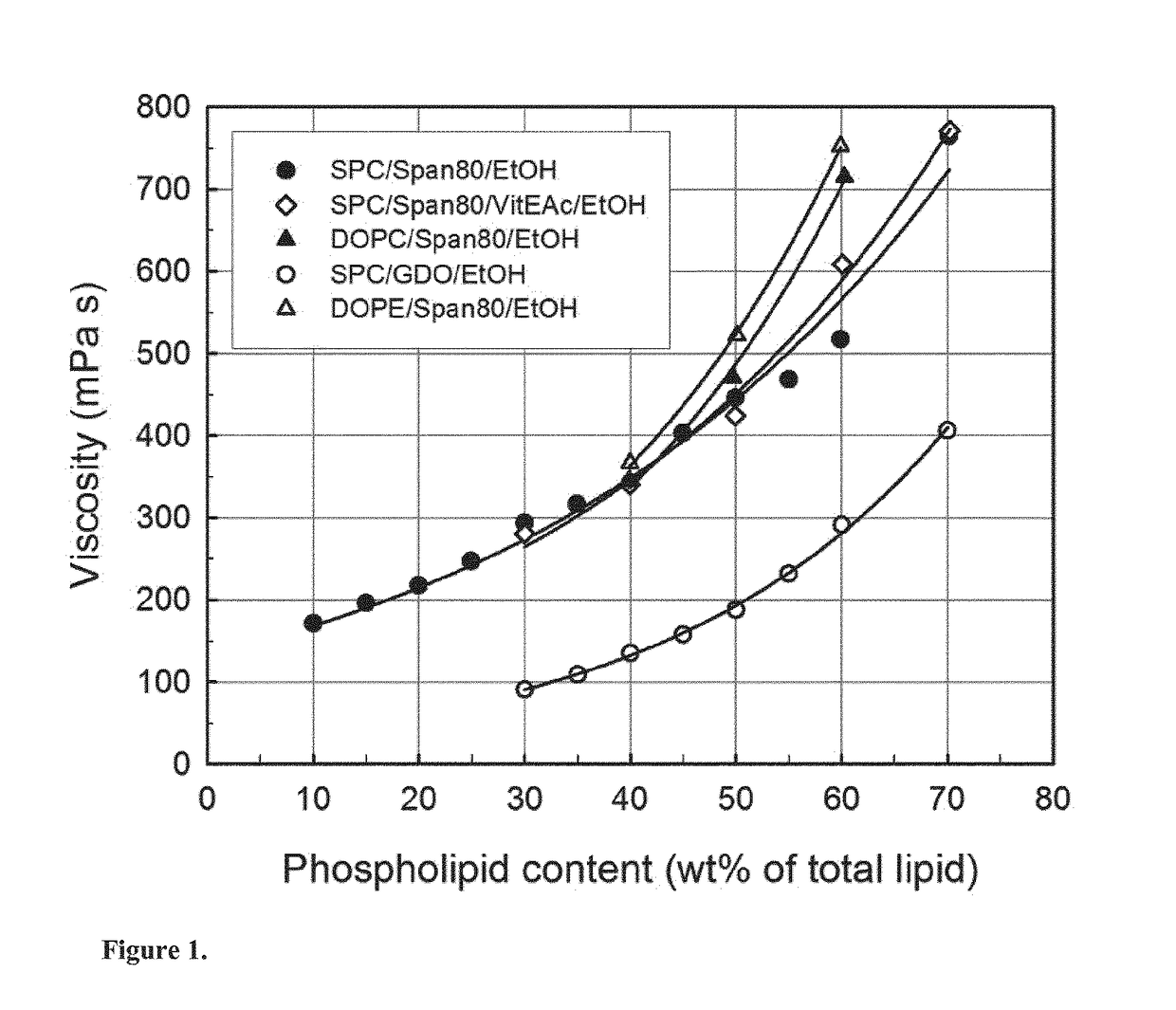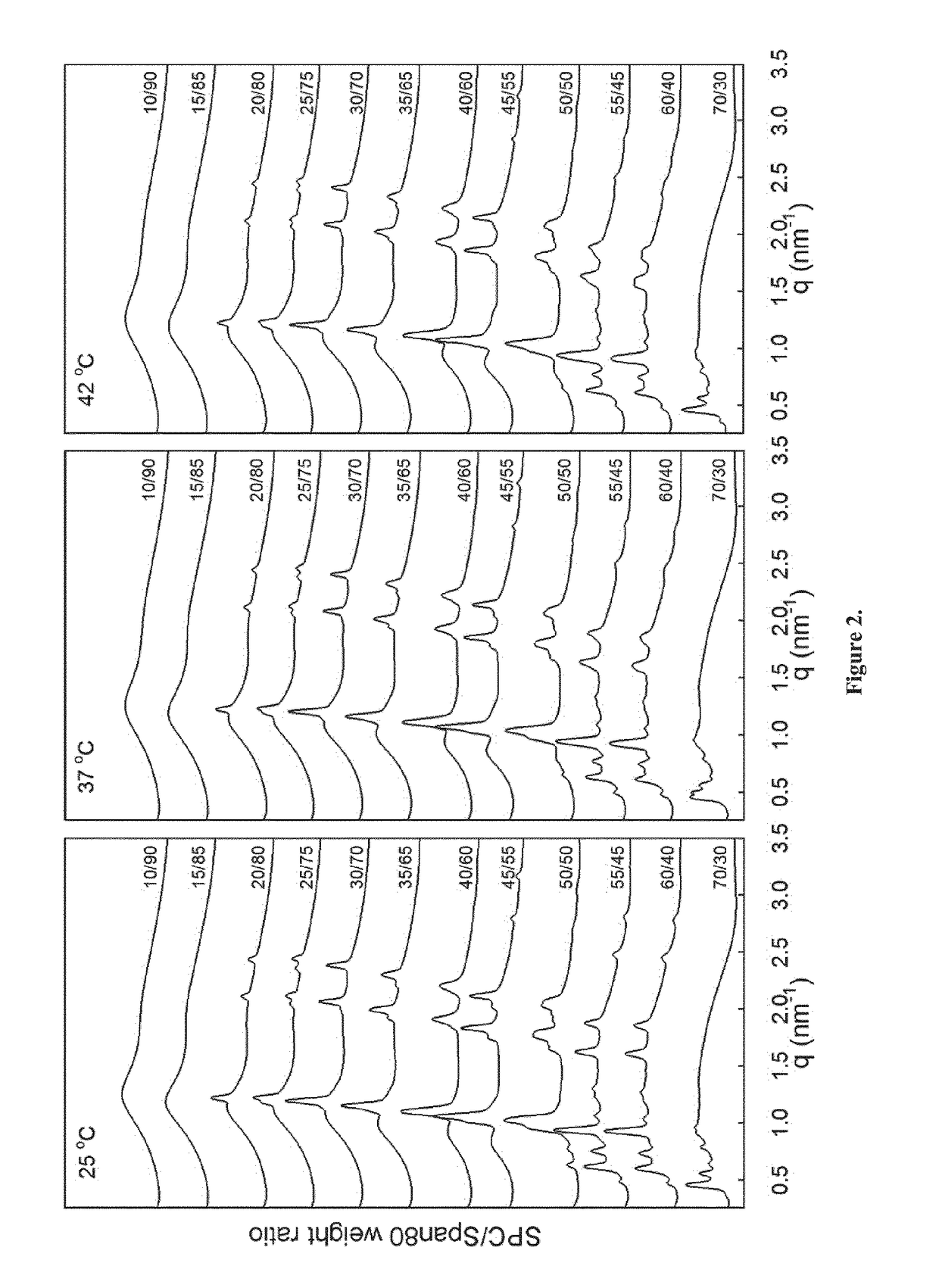Controlled-release formulations
a technology of formulation and controlled release, applied in the field of formulation precursors, can solve the problems of poor compliance, unsatisfactory or even dangerous effects, and general limited performance of administered peptide agents, and achieve the effect of low viscosity
- Summary
- Abstract
- Description
- Claims
- Application Information
AI Technical Summary
Benefits of technology
Problems solved by technology
Method used
Image
Examples
example 1
Liquid Formulations Comprising Soy Phosphatidylcholine And Span® 80
[0193]Precursor formulations containing different proportions of soy phosphatidylcholine (SPC), sorbitan monooleate (Span® 80) and ethanol (EtOH) as solvent were prepared. Appropriate amounts of SPC, Span® 80 and EtOH (3 g in total) were weighed in 6R injection glass vials. Sealed vials were then placed on a roller mixer at room temperature until mixed completely into clear homogeneous liquid solution (<24 hours). Sample compositions are given in Table 2.
TABLE 2Compositions of SPC / Span ®80 / EtOH formulations.FormulationSPCSpan ®80EtOHSPC / Span ®80No(wt %)(wt %)(wt %)(weight ratio)#163.0027.0010.0070 / 30#254.0036.0010.0060 / 40#349.5040.5010.0055 / 45#445.0045.0010.0050 / 50#540.5049.5010.0045 / 55#636.0054.0010.0040 / 60#731.5058.5010.0035 / 65#827.0063.0010.0030 / 70#922.5067.5010.0025 / 75#1018.0072.0010.0020 / 80#1113.5076.5010.0015 / 85#129.0081.0010.0010 / 90
example 2
Liquid Formulations Comprising Dioleoylphosphatidylcholine and Span® 80
[0194]Precursor formulations containing different proportions of dioleoylphosphatidylcholine (DOPC), sorbitan monooleate (Span® 80) and ethanol (EtOH) as solvent were prepared. Appropriate amounts of DOPC, Span® 80 and EtOH (3 g in total) were weighed in 6R injection glass vials. Sealed vials were then placed on a roller mixer at room temperature until mixed completely into clear homogeneous liquid solution (<24 hours). Sample compositions are given in Table 3.
TABLE 3Compositions of DOPC / Span ®80 / EtOH formulations.FormulationDOPCSpan ®80EtOHDOPC / Span ®80No(wt %)(wt %)(wt %)(weight ratio)#1354.0036.0010.0060 / 40#1445.0045.0010.0050 / 50#1536.0054.0010.0040 / 60
example 3
Liquid Formulations Comprising Dioleoylphosphatidylethanolamine and Span® 80
[0195]Precursor formulations containing different proportions of dioleoylphosphatidylethanolamine (DOPE), sorbitan monooleate (Span® 80) and ethanol (EtOH) as solvent were prepared. Appropriate amounts of DOPE, Span® 80 and EtOH (3 g in total) were weighed in 6R injection glass vials. Sealed vials were then placed on a roller mixer at room temperature until mixed completely into clear homogeneous liquid solution (<24 hours). Sample compositions are given in Table 4.
TABLE 4Compositions of DOPE / Span ®80 / EtOH formulations.FormulationDOPESpan ®80EtOHDOPE / Span ®80No(wt %)(wt %)(wt %)(weight ratio)#1654.0036.0010.0060 / 40#1745.0045.0010.0050 / 50#1836.0054.0010.0040 / 60
PUM
| Property | Measurement | Unit |
|---|---|---|
| wt. % | aaaaa | aaaaa |
| wt. % | aaaaa | aaaaa |
| wt. % | aaaaa | aaaaa |
Abstract
Description
Claims
Application Information
 Login to View More
Login to View More - R&D
- Intellectual Property
- Life Sciences
- Materials
- Tech Scout
- Unparalleled Data Quality
- Higher Quality Content
- 60% Fewer Hallucinations
Browse by: Latest US Patents, China's latest patents, Technical Efficacy Thesaurus, Application Domain, Technology Topic, Popular Technical Reports.
© 2025 PatSnap. All rights reserved.Legal|Privacy policy|Modern Slavery Act Transparency Statement|Sitemap|About US| Contact US: help@patsnap.com



